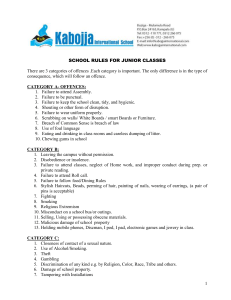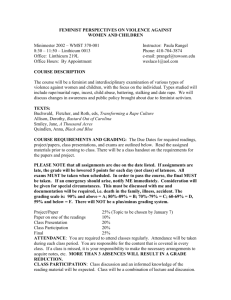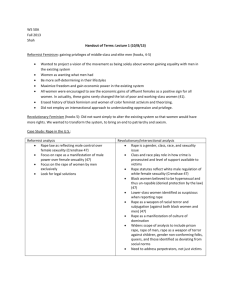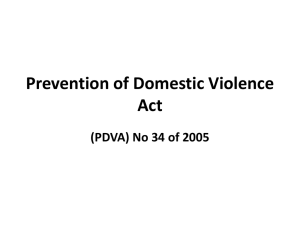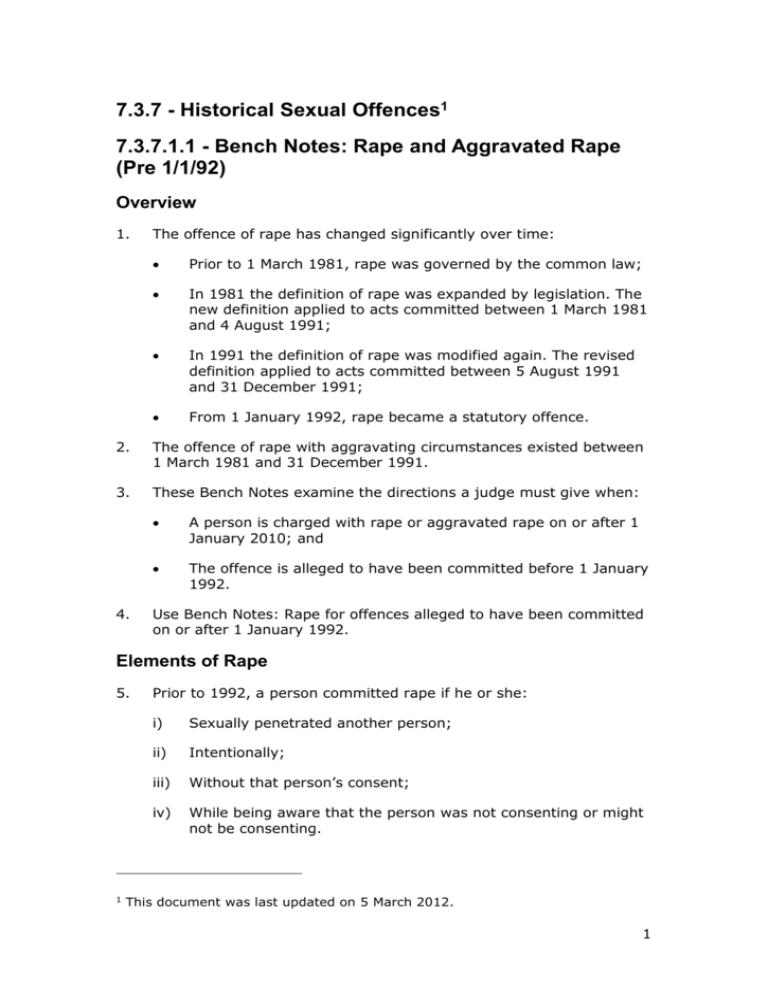
7.3.7 - Historical Sexual Offences1
7.3.7.1.1 - Bench Notes: Rape and Aggravated Rape
(Pre 1/1/92)
Overview
1.
The offence of rape has changed significantly over time:
Prior to 1 March 1981, rape was governed by the common law;
In 1981 the definition of rape was expanded by legislation. The
new definition applied to acts committed between 1 March 1981
and 4 August 1991;
In 1991 the definition of rape was modified again. The revised
definition applied to acts committed between 5 August 1991
and 31 December 1991;
From 1 January 1992, rape became a statutory offence.
2.
The offence of rape with aggravating circumstances existed between
1 March 1981 and 31 December 1991.
3.
These Bench Notes examine the directions a judge must give when:
4.
A person is charged with rape or aggravated rape on or after 1
January 2010; and
The offence is alleged to have been committed before 1 January
1992.
Use Bench Notes: Rape for offences alleged to have been committed
on or after 1 January 1992.
Elements of Rape
5.
1
Prior to 1992, a person committed rape if he or she:
i)
Sexually penetrated another person;
ii)
Intentionally;
iii)
Without that person’s consent;
iv)
While being aware that the person was not consenting or might
not be consenting.
This document was last updated on 5 March 2012.
1
6.
Judges should take care not to run these elements together when
directing the jury. In particular, judges should not instruct the jury
that the fourth element relates to “the guilty mind of the accused”,
or that the prosecution must prove that the accused “intended to
commit the crime of rape in the sense that, at the time of sexual
penetration, he [or she] realized that the complainant was not
consenting or might not be consenting” (R v Soldo [2005] VSCA 136;
R v Zilm (2006) 14 VR 11; [2006] VSCA 72 per Callaway JA).
“Sexual Penetration”
7.
The meaning of “sexual penetration” for the purpose of this offence
has been significantly modified over time.
Offences Committed Before 1 March 1981
8.
The common law definition of “sexual penetration” applies to
offences committed before 1 March 1981.
9.
At common law, “sexual penetration” only consisted of penetration of
a vagina by a penis. Other forms of sexual penetration were
considered to be incidents of indecent assault, rather than rape (see
R v Daly [1968] VR 257; R v Hornbuckle [1945] VLR 281).
10. This element was met when there was any penetration of the
complainant’s labia by the penis (R v Lines (1844) 1 Car & K 393;
Randall v R (1991) 53 A Crim R 380).
11. From 5 August 1991, the Crimes Act 1958 defined vagina to include
a surgically constructed vagina. It is unclear whether the common
law recognised penetration of an artificially constructed sexual organ
as sexual penetration (see R v Cogley [1989] VR 799; R v Harris &
McGuiness (1988) 17 NSWLR 158).
12. This element was met by penetration “to any extent”. Consequently:
The penetration only needed to be slight or fleeting; and
It was not necessary for the prosecution to prove that semen
was emitted (see Randall v R (1991) 53 A Crim R 380;
Anderson v R [2010] VSCA 108; R v Pryor [2001] QCA 341).
13. It is not sufficient for the relevant body part to have simply been
touched. It must have been penetrated to some extent (Anderson v
R [2010] VSCA 108).
14. It is unclear whether this element will be met where:
The complainant stops consenting, and the accused fails to
cease the penetration; or
The accused becomes aware that the complainant is not
consenting, but fails to cease the penetration (see Salmon v R
2
[1969] SASR 76; Saraswati v R (1991) 100 ALR 193 per
Dawson J; R v Murphy (1988) 52 SASR 186; R v Mayberry
[1973] Qd R 211; Richardson v R [1978] Tas SR 178; Kaitamaki
v R [1985] AC 147).
Offences Committed 1 March 1981 - 4 August 1991
15. From 1 March 1981 to 4 August 1991, the definition of rape was
expanded to also include:
The introduction (to any extent) of a person’s penis into the
anus or mouth of another person of either sex; and
The introduction (to any extent) of an object that is not part of
the body, and which was manipulated by a person of either sex,
into the vagina or anus of another person of either sex (Crimes
Act 1958 s2A).
16. This definition removed the gendered nature of the offence, which
previously could only be committed by a male against a female.
Under this definition:
Both males and females can be the victim of the offence; and
Both males and females can commit the offence, by using an
object that is not part of the body.
17. It is unclear whether the expanded definition uses the medical
meaning of “vagina” (being the membranous passage or channel
leading from the uterus to the vulva), or whether it should be
interpreted in a manner consistent with the common law
understanding of “sexual penetration” (which includes penetration of
the external genitalia) (compare R v Lines (1844) 1 Car & K 393 and
Holland v R (1993) 117 ALR 193. See also Randall v R (1991) 53 A
Crim R 380 and R v AG (1997) 129 ACTR 1).2 In cases where this is
relevant, judges will need to engage in a process of statutory
construction and will need to consider principles concerning the
interpretation of ambiguous penal statutes and the interference with
fundamental rights (see Coco v R (1994) 179 CLR 427; Bropho v
State of Western Australia (1990) 171 CLR 1; Beckwith v R (1976)
135 CLR 569).
18. As was the case at common law, under the expanded definition:
The penetration only needed to be slight or fleeting (penetration
“to any extent”) (Randall v R (1991) 53 A Crim R 380;
Anderson v R [2010] VSCA 108);
If the legislation uses the medical definition, cases in which only the external
genitalia have been penetrated will need to be charged as indecent assault
instead.
2
3
The prosecution did not need to prove the emission of semen
(Crimes Act 1958 s2A);
It is unclear whether this element is met where the accused
failed to cease sexual penetration upon withdrawal of consent,
or upon becoming aware that the complainant was not
consenting (see Salmon v R [1969] SASR 76; Saraswati v R
(1991) 100 ALR 193 per Dawson J; R v Murphy (1988) 52 SASR
186; R v Mayberry [1973] Qd R 211; Richardson v R [1978] Tas
SR 178; Kaitamaki v R [1985] AC 147).
19. The purpose of the penetration is irrelevant. It need not have been
committed for the purposes of sexual gratification (R v Dunn
15/4/1992 CA NSW).
Offences Committed 5 August 1991 – 31 December 1991
20. From 5 August 1991 to 31 December 1991, the definition of rape was
further expanded, to include:
The introduction of a part of the body other than the penis into
the vagina or anus of another person; and
Failing to cease sexual penetration on becoming aware that the
other person was not consenting, or upon realising that the
other person might not be consenting (Crimes Act 1958 s36).
Directing the Jury About the Meaning of “Vagina”
21. The common law definition of vagina (and possibly the statutory
definitions: see above) includes “the external genitalia”. It has been
held that this phrase is not within ordinary usage and needs more
explanation (R v AJS (2005) 12 VR 563; Anderson v R [2010] VSCA
108; R v MG [2010] VSCA 97).
22. Consequently, where penetration is in issue, the judge should explain
to the jury in precise and simple terms, what would constitute
penetration of the vagina, and summarise the evidence that relates
to that issue (R v AJS (2005) 12 VR 563. See also Randall v R (1991)
53 A Crim R 380; Anderson v R [2010] VSCA 108; R v MG [2010]
VSCA 97).
Identifying the Penetrative Act
23. While in most cases the prosecution will be able to particularise the
method of penetration (e.g., the complainant was penetrated by a
penis), in some cases this will not be possible. In such cases, it will
be sufficient for the prosecution to particularise the method of
penetration by reference to the relevant possibilities (e.g., the
complainant was penetrated by a penis, a bodily part or some other
object) (R v Castles (Ruling No.1) [2007] VSC 561).
24. Where alternative possible methods of penetration are left to the
4
jury, they do not need to unanimously agree about which of those
methods was used. They only need to unanimously agree that
penetration took place (R v Castles (Ruling No.1) [2007] VSC 561).
Lack of Consent
25. The third element the prosecution must prove is that the complainant
did not consent to sexual penetration (R v Saragozza [1984] VR
187).
26. While the statutory definition of consent in Crimes Act 1958 s36 was
introduced on 1 January 1992 by the Crimes (Rape) Act 1991, the
transitional provisions for that Act state that it applies to proceedings
that occur after the commencement of the legislation, regardless of
when the alleged offence was committed (Crimes (Rape) Act 1991
s9).
27. Similarly, the amendments to the statutory directions on consent and
awareness of the absence of consent introduced by the Crimes
(Rape) Act 2007 also operate retrospectively (Crimes Act 1958
s609).
28. While there is an argument that s36 is incapable of applying to rape
before prior to 1 January 1991, as the section is limited to offences
under Subdivisions (8A) to (8D), the better view appears to be that,
in light of the transitional provisions of the Crimes (Rape) Act 1991,
the section does operate retrospectively and judges must direct
juries on the contemporary meaning of consent, even for historical
offences.
29. For information on the meaning of consent under s36 and the
statutory directions on consent, see Bench Notes: Consent and
Awareness of Non-Consent.
Awareness of Non-Consent
30. The fourth element the prosecution must prove is that the accused
was aware that the complainant was not consenting to the sexual
penetration, or realised that the complainant might not be
consenting to the sexual penetration (R v Flannery & Prendergast
[1969] VR 31; R v Hornbuckle [1945] VLR 281; R v Daly [1968] VR
257; R v Morgan [1976] AC 182; Banditt v R (2005) 224 CLR 262; R
v Saragozza [1984] VR 187).
31. The prosecution does not need to prove that the accused realised
that the complainant probably was not consenting. It is sufficient to
prove that the accused realised the complainant might not be
consenting (R v Hemsley (1988) 36 A Crim R 334. See also R v
Morgan [1976] AC 182; R v Daly [1968] VR 257).
32. The reasonableness of an accused’s asserted belief in consent is
relevant only to the question of whether the belief was held. The law
5
does not treat an unreasonable belief as non-existent or irrelevant (R
v Saragozza [1984] VR 187; R v Morgan [1976] AC 182).
33. The existence of a belief in consent (whether reasonable or
unreasonable) is necessarily inconsistent with an awareness that the
complainant is not consenting or might not be consenting (R v
Flannery & Prendergast [1969] VR 31; R v Saragozza [1984] VR
187; R v Morgan [1976] AC 182).
34. For more information on this element, see Bench Notes: Consent and
Awareness of Non-Consent.
Non-Advertence
35. Some cases have suggested that this element will be satisfied, both
at common law and under subsequent statutory schemes, where a
person did not give any thought to whether the complainant
consented (see R v Morgan [1976] AC 182; R v Tolmie (1995) 37
NSWLR 660).
36. However, the Crimes Amendment (Rape) Act 2007 was enacted on
the basis that an offence would not be committed where the accused
did not advert to the issue. The transitional provisions limit the
operation of the statutory fault element of non-advertence to
offences committed after the commencement of the amending
legislation (see Attorney-General Rob Hulls, Second Reading Speech,
Crimes Amendment (Rape) Bill 2007. See also Neal v R [2011] VSCA
172).
37. The charges in the Charge Book reflect the latter view (i.e., that this
element cannot be proven by establishing non-advertence). If this
position is considered to be incorrect, the charges will need to be
modified accordingly.
Rape with Aggravating Circumstances
38. The offence of rape with aggravating circumstances existed between
1 March 1981 and 31 December 1991.
39. The accused can be found guilty of this offence in two ways:
The jury can convict him or her of rape with aggravating
circumstances, if they are satisfied that all of the elements of
that offence have been met; or
The judge can direct that the accused is deemed to have been
found guilty of rape with aggravating circumstances, if he or
she is satisfied that the accused has previously been convicted
of a specified offence.
Jury Determination
40. “Rape with aggravating circumstances” is a separate offence from
6
“rape”. If the prosecution charges the accused with the aggravated
offence, the judge must direct the jury about its elements (subject to
the power of the judge to direct a verdict of rape with aggravating
circumstances: see below) (Crimes Act 1958 s45).
41. The offence consists of all the elements of rape, along with an
additional element that the offence was committed in one of the
following aggravating circumstances:
a)
During the commission of the offence, or immediately before or
after it, and at or in the vicinity of the place where the offence
was committed, the offender inflicted serious personal violence
on the victim or another person;
b)
The offender had an offensive weapon with him or her;
c)
During the commission of the offence, or immediately before or
after it, the offender did an act which was likely to seriously and
substantially degrade or humiliate the victim; or
d)
During the commission of the offence, or immediately before or
after it, the offender was aided or abetted by another person
who was present at, or in the vicinity of, the place where the
offence was committed (Crimes Act 1958 ss45, 46).
42. The term “offensive weapon” means an offensive weapon, firearm,
imitation firearm, explosive or imitation explosive, as defined in s77
of the Act (Crimes Act 1958 ss45, 46).
43. See Bench Notes: Aggravated Burglary for further information
concerning the meaning of “offensive weapon”, as well as the
requirement that the accused had the weapon “with” him or her.
Directed Verdict
44. Where the accused is found guilty of rape, the judge may direct that
he or she is deemed to have been found guilty of rape with
aggravating circumstances if the judge is satisfied that the accused
has previously been convicted of one of the following offences:
Rape (with or without aggravating circumstances);
Rape with mitigating circumstances;3
Attempted rape (with or without aggravating circumstances);
Assault with intent to rape (with or without aggravating
circumstances);
Prior to 1 March 1981, s44(2) of the Crimes Act 1958 allowed the jury on a
charge of rape to return a verdict of rape with mitigating circumstances, if
satisfied that the accused committed the offence in circumstances of mitigation.
3
7
Indecent assault (with or without aggravating circumstances)
(Crimes Act 1958 s46).
45. The power to direct a deemed verdict of rape with aggravating
circumstances applies even if the accused pleaded guilty. It is not
limited to a finding of guilt following a trial (R v Symons [1981] VR
297; R v Snabel, VSC, 2/12/1982).
Rape with Mitigating Circumstances
46. Prior to 1 March 1981, s44(2) of the Crimes Act 1958 allowed the
jury on a charge of rape to return a verdict of rape with mitigating
circumstances, if satisfied that the accused committed the offence,
but that there were circumstances connected with the commission of
the offence which mitigate the offence.
47. It is unclear whether the repeal of this provision by the Crimes
(Sexual Offences) Act 1980 removed the availability of the verdict of
rape with mitigating circumstances. Where the parties raise this
issue, the judge will need to consider whether this verdict is available
for offences committed before 1 March 1981 and what assistance the
judge should give the jury on the meaning of “mitigating
circumstances”. However, it may be difficult to reconcile the
existence of this provision with the operation of Crimes Act 1958
ss37A and 37B.4
48. This Charge Book does not provide a model direction on leaving a
verdict of rape with mitigating circumstances.
Other Relevant Statutory Provisions
Crimes Act 1958 s61 (Delayed Complaint)
49. Section 61 of the Crimes Act 1958 contains a number of jury
warnings that are relevant to trials for sexual offences. This section
applies to trials “for an offence under Subdivision (8A), (8B), (8C),
(8D) or (8E) or under any corresponding previous enactment…”.
50. As rape was an offence against s45 of the Crimes Act 1958 between
1 March 1981 and 31 December 1991, s61 applies to offences
committed between those dates. See the documents in 4.9: Delayed
Complaint for further information.
51. It is unclear whether s61 also applies to offences committed before 1
March 1981, as there was no “corresponding previous enactment” at
that time (rape was purely a common law offence).
By Crimes Act 1958 s606A(1), the guiding principles provisions in ss37A and
37B apply to any trial commenced after 1 December 2006, regardless of when
the offence was allegedly committed.
4
8
52. If s61 does not apply to offences committed before 1 March 1981,
then in relevant cases the judge will need to direct the jury about the
effect of delayed complaint in accordance with the common law. See
Bench Notes: Effect of Delayed Complaint on Credit.
Evidence Act 2008
53. Judges will also need to consider the operation of the Evidence Act
2008, which applies to all hearings commenced on or after 1 January
2010 (Evidence Act 2008 Schedule 2).
54. For information on the effect of the Evidence Act 2008, see
especially:
Bench Notes: Delay Causing Forensic Disadvantage; and
Bench Notes: Corroboration (General Principles).
Crimes Act 1958 s62 (Presumption of Consent)
55. Section 62 of the Crimes Act 1958 abolished two presumptions
thought to exist at common law:
The presumption of impotence of a male under the age of 14;
and
The presumption of consent to sexual intercourse within a
marriage.
56. This provision only applies to offences committed on or after 1 March
1981 (Crimes (Sexual Offences) Act 1980 s2).
57. However, recent cases have questioned whether the common law
actually recognised a presumption of consent within marriage.
Depending on the resolution of this issue, the abolition of that
presumption by s62(2) may be redundant (see R v L (1991) 174 CLR
379; R v P, GA [2010] SASCFC 81 (special leave to appeal granted)).
9

